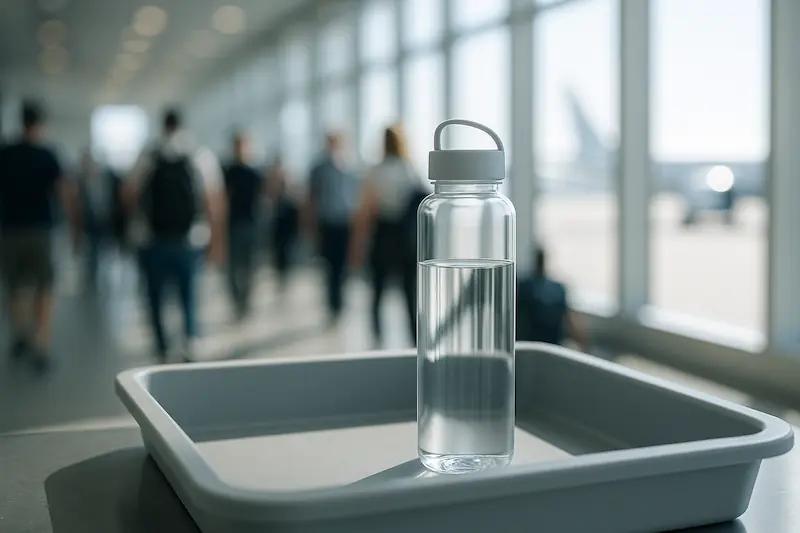Navigating airport security doesn’t have to be stressful. If you’ve ever wondered whether your reusable water bottle will make it through the checkpoint, here’s the straightforward answer: yes, it will—as long as it’s empty.
Empty water bottles are permitted at airports worldwide. This includes metal, plastic, collapsible, and insulated varieties. The key is understanding a few simple guidelines to ensure smooth passage through security.
This comprehensive guide covers everything you need to know about traveling with water bottles, plus helpful information about other items you can bring aboard.
The Basic Rule: Empty Bottles Pass Security
Global Airport Policies Align
Transportation security agencies across the world—including the TSA, European authorities, and airport systems in Canada, Australia, and Asia—permit empty water bottles through screening checkpoints.
The restriction applies to liquids, not containers. Once your bottle is emptied, it becomes just another personal item in your carry-on.
Your bottle material doesn’t matter:
- Stainless steel
- Plastic varieties
- Tritan
- Silicone collapsible designs
- Double-walled insulated types
- Large sports bottles
All pass inspection when empty.
The Logic Behind the Policy
Security protocols focus on liquid content because concealed substances pose potential risks. An empty container presents no such concern.
Many airports now actively encourage reusable bottles as part of sustainability initiatives. Water refill stations have become standard in most modern terminals, making it easy to stay hydrated after clearing security.
Special Situations to Consider
1. Additional Gate Screening
Some international routes include secondary security checks at boarding gates. These commonly occur on flights:
- From the United States to Australia
- To certain Middle Eastern destinations
- Departing from Singapore
- On high-security European routes
During these checks:
- Empty bottles remain acceptable
- Filled bottles require emptying again
This surprises travelers who refill immediately before boarding. Plan accordingly for these routes.
2. Enhanced Screening Procedures
Certain destinations maintain stricter protocols due to international security agreements. Security personnel may ask you to:
- Remove the bottle cap
- Demonstrate the container is empty
- Shake the bottle for verification
These checks take only moments and rarely cause delays.
Using Your Bottle During Flight
Once aboard, your water bottle becomes a practical travel companion.
Flight attendants typically accommodate refill requests from the aircraft’s water system. Benefits include:
- Combating cabin air dryness
- Reducing single-use cup waste
- Preventing spills with secure lids
- Convenient access on long flights
- Easier hydration management for families
The low humidity in aircraft cabins makes regular hydration especially important. Having your own bottle ensures easy access between beverage services.
Bottle Types and Airport Compatibility
Stainless Steel
Security-approved Exceptional durability Superior leak prevention Versatile for various activities
Plastic and Tritan
Minimal weight Child-friendly Impact-resistant
Collapsible Designs
Space-efficient when empty Extremely lightweight Popular among frequent travelers
Insulated Varieties
Permitted when empty Maintains temperature for hours May require cap removal during inspection
Hassle-Free Travel Tips
1. Complete Emptying Before Checkpoints
Even small amounts of liquid can trigger additional screening. Pour out every drop before joining the security line.
2. Be Prepared to Open Your Bottle
Security officers occasionally request cap removal for visual confirmation. This quick step prevents misunderstandings.
3. Locate Refill Stations
Post-security hydration stations appear in most contemporary airports. This approach saves money compared to purchasing terminal beverages.
4. Prioritize Leak-Proof Design
Essential for:
- Extended flights
- Turbulent conditions
- Storage in bags or seat pockets
5. Anticipate Gate Screening
Certain routes involve additional checks. Simply empty your bottle if asked—you can often refill once seated.
Additional Carry-On Items You Can Bring
The TSA maintains a detailed database of approved items at: https://www.tsa.gov/travel/security-screening/whatcanibring/all
Many common items receive clearance, including:
- Food items (solid foods like sandwiches, fresh fruit, snacks)
- Electronic devices (computers, cameras, tablets, portable chargers in carry-on bags)
- Empty thermoses and insulated containers
- Disposable razors
- Medical supplies (including liquids exceeding standard limits when declared)
- Infant formula and breast milk
- Travel-sized toiletries following volume regulations
Primary restrictions involve:
- Combustible materials
- Bulk liquids
- Pointed implements
- Specific tools
Understanding these guidelines helps you pack efficiently and avoid checkpoint complications.
Selecting the Right Travel Bottle
Key Features for Air Travel
When choosing a bottle specifically for flying, consider:
- Minimal weight
- Single-handed operation
- Reliable seal technology
- Robust materials (stainless steel or Tritan)
- Size compatibility with seat storage
- Simple maintenance
- Temperature retention (optional)
These characteristics ensure your bottle serves you well throughout your journey and beyond.
Custom Bottle Solutions for Organizations
For businesses seeking custom reusable water bottles for corporate use, we provide:
- Stainless steel travel-oriented bottles
- Lightweight Tritan options
- Collapsible travel designs
- Customizable colors and finishes
- Branding methods: laser engraving, UV printing, silk screening, heat transfer
- Premium packaging solutions
- Volume orders for corporate clients
- OEM and ODM services for unique designs
Contact us to explore product catalogs, request samples, and discuss branding possibilities for your business needs.





Comments